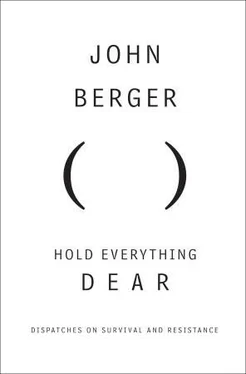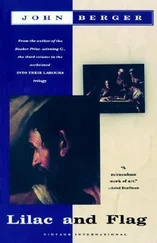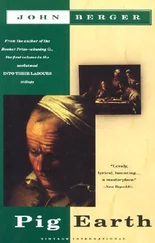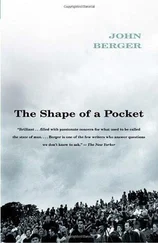I have come to see the most ancient built monument in the world, constructed a thousand years before the earliest pyramids. It too was constructed as a funerary monument. What I'm looking at, Eqbal, is a pile of stones. The guide books call it a cairn.
Yet it's far more than a cairn; it's a highly articulated sculpture. Every forty centimetres of it has been, as it were, hand-written. It's over seventy metres long, about twentyfive metres wide and eight or ten metres tall, and in each direction each stone joins the following one intentionally, as if the stones were hand-written words.
Imagine the deck of a ship. She's heading north-east to get out of the bay of Morlaix, and then she can go west towards America. This ship with her Homeric prow (local legend has it that Odysseus passed by this coast on his way to Cork), this ship is made of stones, and naturally she is married to the earth!
According to the carbon datings, she was built at least six thousand years ago, on two separate occasions. First the stern was made with greenish metamorphic dolerite stones, such as abound along the coast with its acid earth beneath the ferns. Then, a century or two later, the prow was added, made mostly with oat-coloured granite, which came from the little island of Sterec.
There was a third construction which may have been a second ship of death, but this was utterly destroyed in the 1950s, when the whole site, which had long since been overgrown and covered with earth, was being exploited as a quarry, and the stones used for making gravel.
Archaeologists deduce that each part of the ship, on the two occasions, was built within a few months. And this, given the labour involved, presumes that a whole settler community of several hundred people worked together on it.
Most of the stones are the size and weight of what a strong man might carry between his two arms. There are also smaller ones, small as a fist, for filling in the recalcitrant spaces left in the otherwise perfect fitting together of the larger ones.
The ship's decks are smooth, not cobbled. And there are a few megaliths, taller than a man, used as lintels over the entrances to passageways, or, sometimes, as a table-roof for vaulted chambers. On the lower deck, twenty-two drystone passages, from port and starboard, lead to eleven vaulted cabins, where the dead were placed.
I follow one such passage, which is like a sentence leading to a centre, and here, in the half-destroyed sanctuary, I gaze at the stones corbelling out. They are the same as millions of other stones on the beaches of this coast, except that here, they speak and are eloquent, due to their arrangement.
Chaos perhaps has its reasons, but chaos is dumb. From the human capacity to arrange, to place, come language and communication. The word place is both verb and noun. The capacity of arrangement and the capacity to recognize and name a site. Aren't both inseparable in their origin from the human need to respect and defend their dead?
A strange comparison occurs to me. What inspired hundreds of people to work together for several months to build this ship of stones is perhaps quite close to what inspires kids in Palestine to hurl stones at the tanks of an occupying army.
The Chorus in Our Heads or Pier Paolo Pasolini (June 2006)
IF I SAY HEwas like an angel, I can't imagine anything more stupid being said about him. An angel painted by Cosimo Tura? No. There's a St. George by Tura which is his speaking likeness! He abhorred official saints and beatific angels. So why say it? Because his habitual and immense sadness allowed him to share jokes, and the look on his distressed face distributed laughter, guessing exactly who needed it most. And the more intimate his touch, the more lucid it became! He could whisper to people softly about the worst that was happening to them and they somehow suffered a little less,‘… for we never have despair without some small hope.' ‘Disperazione senza un po' di speranza.' Pier Paolo Pasolini (1922–1975).
I think he doubted many things about himself, but never his gift of prophesy which was, perhaps, the one thing he would have liked to have doubted. Yet, since he was prophetic, he comes to our aid in what we are living today. I have just watched a film made in 1963. Astonishingly, it was never publicly shown. It arrives like the proverbial message put in a bottle and washed up forty years later on our beach.
At that earlier time, many people followed world events by watching not the TV news, but newsreels in cinemas. In 1962 G. Ferranti, an Italian producer of such reels, had a bright idea. He would give the already notorious Pasolini access to his news archives from 1945–62, in order to answer the question: Why was there everywhere in the world a fear of war? He could edit whatever material he chose, and write a voice-over commentary. The resulting one-hour film would hopefully boost the newsreel company's prestige. The question was ‘hot' because, at that moment, the fear of yet another World War was indeed widespread. The nuclear warhead crisis between Cuba, the USA and the USSR erupted in October 1962.
Pasolini, who had already made Accattone, Mamma Roma , and La Ricotta , accepted for his own reasons, because he was in love with and at war with History. He made the film, and entitled it La Rabbia (Rage). 1
When the producers saw it, they got cold feet and insisted that a second filmmaker, a notoriously right-wing journalist called Giovanni Guareschi, should now make a second part and that the two films should then be presented as one. As things turned out, neither was shown.
La Rabbia , I would say, is a film inspired by a fierce sense of endurance, not anger. Pasolini looks at what is happening in the world with unflinching lucidity. (There are angels drawn by Rembrandt who have the same gaze.) And he does so because reality is all we have to love. There's nothing else.
His dismissal of the hypocrisies, half-truths and pretences of the greedy and powerful is total because they breed and foster ignorance, which is a form of blindness towards reality. Also because they shit on memory, including the memory of language itself, which is our first heritage.
Yet the reality he loved could not be simply endorsed, for at that moment it represented a too deep historical disappointment. The ancient hopes which flowered and opened out in 1945, after the defeat of Fascism, had been betrayed.
The USSR had invaded Hungary. France had begun its cowardly war against Algeria. The coming to independence of the former African colonies was a macabre charade. Lumumba had been liquidated by the puppets of the CIA. Neo-capitalism was already planning its global take-over.
Yet despite this, what had been bequeathed was far too precious and too tough to abandon. Or, to put it another way, the unspoken ubiquitous demands of reality were impossible to ignore. The demand in the way a shawl was worn. In a young man's face. In a street full of people demanding less injustice. In the laughter of their expectations and the recklessness of their jokes. From this came his rage of endurance.
Pasolini's answer to the original question was simple: The class struggle explains war.
The film ends with an imaginary soliloquy by Gagarin, after he has seen the planet from outer space, in which he observes that all men, seen from that distance away, are brothers who should renounce the planet's bloody practices.
Essentially, however, the film is about experiences which both the question and answer leave aside. About the coldness of winter for the homeless. About the warmth that the remembering of revolutionary heroes can offer, about the irreconcilability of freedom and hate, about the peasant flair of Pope John XXIII whose eyes smile like a tortoise, about Stalin's faults which were our faults, about the devilish temptation of thinking any struggle is over, about the death of Marilyn Monroe and how beauty is all that remains from the stupidity of the past and the savagery of the future, about how Nature and Wealth are the same thing for the possessing classes, about our mothers and their hereditary tears, about the children of children of children, about the injustices that follow even a noble victory, about the little panic in the eyes of Sophia Loren when she watches a fisherman's hands cutting open an eel …
Читать дальше












